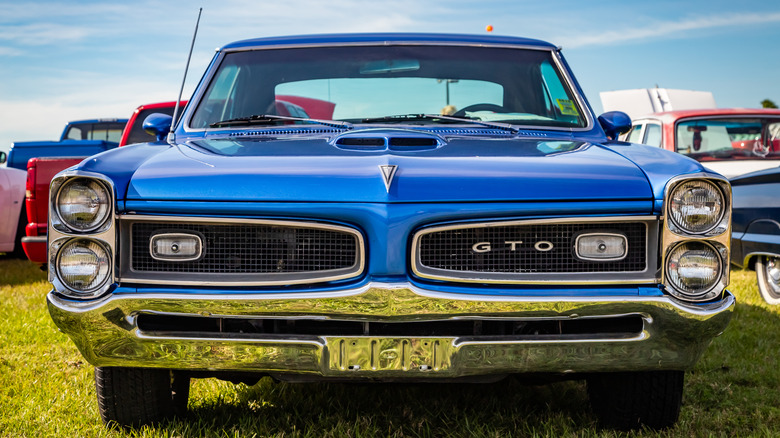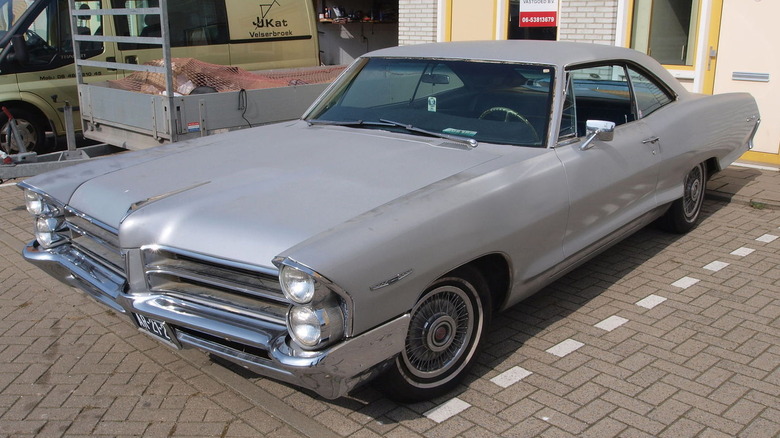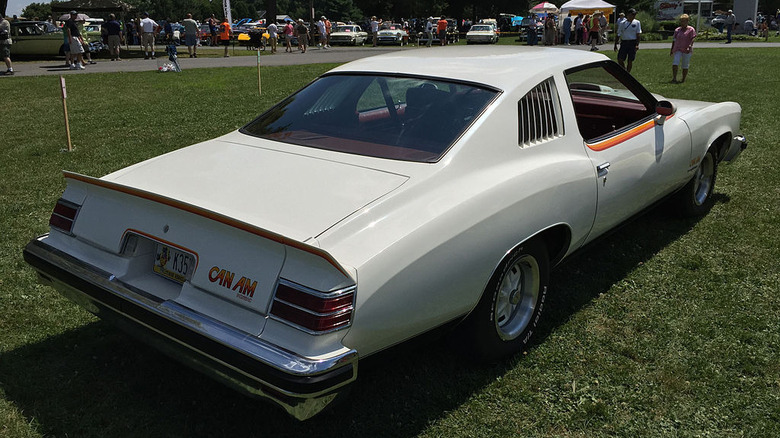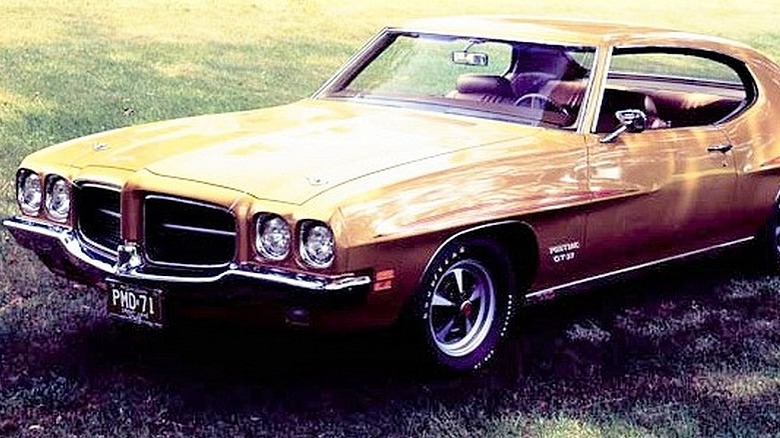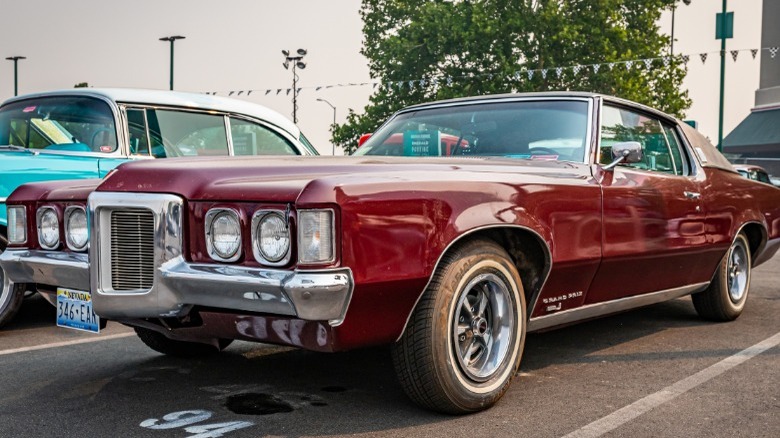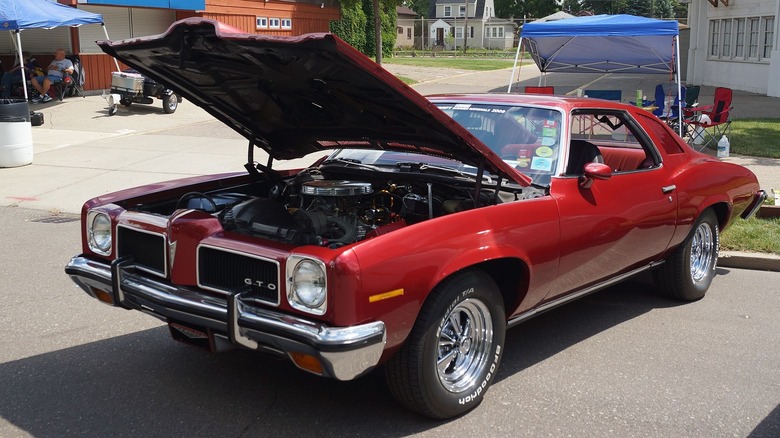5 Of The Most Underappreciated Pontiac Muscle Cars
Pontiac is largely credited for the beginning of the muscle car era with it's release of the 1966 GTO. While there were muscle cars before the original GTO was launched in 1964, and particularly after that time, the GTO was the breakthrough that made every other American car company jump in the race for the best muscle car.
Pontiac wasn't finished, though: The automaker would come out with at least two totally iconic muscle cars after that with the Firebird and the Trans Am. You might remember the Burt Reynolds movie "Smokey and the Bandit," which co-starred Sally Field, but the best supporting actor (in our minds) is going to that gold-trimmed Trans Am.
Those are the cars everyone remembers, but there are several lesser known Pontiac cars that fit the muscle car profile. Some were forgotten because they were the "cheaper" versions, or were only sold for one year, while others just remained in the shadows of the top-tier cars.
1965 Pontiac Catalina 2+2
One year before the unveiling of the 1966 Pontiac GTO that would change the auto industry, the company put out another great car — the 1965 Pontiac Catalina 2+2. While the Bonneville was Pontiac's top of the line car at the time, the Catalina shared similar power train options at a lower-end price.
It had stacked headlights and the traditional split-grill aesthetic that was the signature for Pontiac cars of the era. It came with a 338 horsepower, four-barrel 421-cube V-8 as standard equipment; but you could upgrade to a 376 horsepower, 421 H.O. cube V-8 engine. That upgrade also included added chrome body details as part of the package.
The Catalina was a pretty solid car all around, but it wasn't without its flaws. Sometimes, valve cover gaskets would leak, and there could be coolant seepage when the intake was installed before the water pump. Minor design flaws aside, the Pontiac Catalina 2+2 was a mean-looking muscle car that was sure to turn heads in its time, even though it ended up being underappreciated by many car lovers.
[Image by AlfvanBeem via Wikimedia Commons | Cropped and scaled | CC0 1.0]
1977 Pontiac LeMans Can Am
Most car historians say the muscle car era ended in 1973, but that wouldn't stop manufacturers from churning them out for a few more years, which brings us to the next underappreciated car: the 1977 Pontiac LeMans Can Am.
While it was a bigger car promising more space for the family, under the hood it was a legit muscle car. It featured the same engine as the Trans Am, with a 400 cubic inch V-8. While many cars of the era offered both manual and automatic transmissions, the LeMans Can Am only offered the Turbo Hydra-Matic 400 automatic.
Part of what made the Can Am iconic were the decals, stickers, and special body tweaks that gave it its own unique look. Unfortunately, they were also part of the problem, because Pontiac sent the car to another outside company to take care of those details and the process had a frequent and unwanted problem of breaking the rear spoiler.
As such, if you wanted to rebuild the Can Am these days, you could find nearly every part, but that rear spoiler is not in production anywhere, and looting junk yards would be of little help. Still, with its iconic look and styling, the Can Am is the type of car that people would ask what's under the hood.
[Image by CZmarlin via Wikimedia Commons | Cropped and scaled | CC BY-SA 4.0]
1971 Pontiac GT-37
Sometimes referred to as the "poor man's GTO," the 1971 Pontiac GT-37 is a solid muscle car that betrays that moniker. It was still very much a performance vehicle in its own right with a 400 cubic inch engine that could be upgraded to a 455 cubic inch engine. What's important to note about this car is that it was released in the middle of 1970, and it was advertised as a stripped-down GTO, so it suffered in the shadow of that breakthrough car.
The reality is that when people started looking at rebuilding these classic muscle cars, suddenly the GT-37 looked more and more attractive at a lower price than the original classics. The secret was they packed the same amount of punch.
In other words, the GT-37 was a solid muscle car that was consistently outshined by the fame of the original GTO. Even so, with it's swooping design, low-profile back end, and relatively lower weight compared with other muscle cars, it's a shame it was only offered for about two years before Pontiac moved on.
[Image by Tripower65 via Wikimedia Commons | Cropped and scaled | CC BY-SA 4.0]
1969 Pontiac Grand Prix
When the lure of the full-size cars started to wane towards the end of the 60s, Pontiac decided to aim for more mid-sized vehicles, but that didn't make the Grand Prix any less of a muscle car. The car had a very distinctive style, especially in the wavey details of the raised hood and the "beak," or grill. This grill was split (as is the signature look of many Pontiacs), but it actually extruded outwards to be the nose of the car. When you see it, it's hard to forget.
Known for its ridiculously long hood that was trendy at the time, the Grand Prix was a mix somewhere between a muscle car and a luxury sedan. It had flush door handles like an Alpha Romeo, concealed windshield wipers, and the radio antenna was embedded in the windshield. For all its luxury features, it also had power. The Grand Prix came with a 370-horsepower 428 engine, or the optional 390-horsepower 428 H.O.
So while it may have been overlooked because of its luxury stylings, under the hood, the Grand Prix had everything you'd want in a muscle car. The front disk breaks (uncommon in muscle cars of the era) didn't hurt either.
1973 Pontiac GTO
While we may have left the original Pontiac GTO out of this lineup, by 1973, the muscle car era was mostly over. Still, Pontiac had a new direction to go with its original top-seller, and the 1973 version is definitely worth checking out. What's important to note is that in 1973, new federal regulations were coming into play to quell pollution and unleaded gas was on the uptick across the country.
While most car companies started to gut muscle cars in favor of more environmentally-friendly options, Pontiac went for one last "hoorah" with the 1973 Pontiac GTO. The GTO seemingly had the engine of a muscle car, with options for both a 400 cubic inch V-8, and an optional 455 cubic inch V-8, but the various new regulations took a lot of power out of the car.
That said, Pontiac had a lot of practice with previous versions and used its ingenuity to provide a better suspension, better handling, and an overall smoother ride than any GTO before it. Though some muscle car enthusiasts look sideways at the 1973 GTO as less than it should have been, people who have driven them say their handling and power still make them great muscle cars.
[Image by Greg Gjerdingen via Wikimedia Commons | Cropped and scaled | CC BY 2.0]
